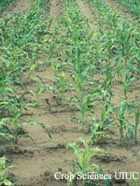Seed and Seedling Diseases


Symptoms:
- Disease damage may appear similar to some environmental stress, but general and specific symptoms can help with diagnosis.
- General effects: reduced emergence, slow growth and stunting in a random or circular pattern, wilting, chlorosis/yellowing, post-emergence damping-off.
- Specific symptoms of seed and root infections include: rotted seed and seedlings before or after emergence; red/yellow discoloration of leaves; complete or partially rotted roots with firm or soft, brown-reddish- to gray lesions or decay; discolored and soft coeleoptile; death of leaf tips; wilting; and sunken,discolored lesions on mesocotyl.
- Leaf spots and streaks can also occur, resulting from anthracnose and Stewarts wilt infections.
Pathogen Involved:
- ·Some common genera of `fungal' pathogens that cause one or more of the symptoms noted above are Stenocarpella (Diplodia), Pythium, Rhizoctonia, Fusarium, Colletotrichum, and Penicillium.
- Two bacterial pathogens that can affect corn seedlings are Erwinia [=Pantoea] (Stewart's Wilt) and Pseudomonas (holcus spot).
- The source of these pathogens is soil, infested residue remaining from previous years crops, or infested seed.
- Nematodes can also damage corn seedlings, especially in sandy soils.
Conditions Favoring Disease:
- The frequency of infection and importance of these pathogens will vary and depend in part on location, seed quality (cracked or infected seed), soil temperatures <55°F, soil water content, soil compaction, rate of emergence and growth, hybrid/inbred, fertilizer burn, herbicide injury, crusted soil, high temperatures (Penicillium infection), and population of flea beetles (Stewart's wilt). · Favorable conditions are cool, wet, and compacted soil, and poor seed quality. For example, Pythium is a common soil fungal-like pathogen that causes seed and seedling rots, and is favored by damaged seed and wet and cool soil conditions.
Disease Management:
- Plant into soil greater than 50-55°F.
- Use seed treated with fungicides. However, these chemicals are most effective for about 2 weeks after planting depending on soil water content and temperature.
- The primary fungicidal seed treatments used are of two main groups. The first group (ApronXL, Allegiance, and Apron) is most effective against Pythium. The second group of fungicides (Maxim, Captan, and Dynasty are common examples) protect against the other fungi.